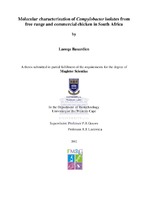| dc.contributor.advisor | Gouws, P.A | |
| dc.contributor.advisor | Lastovica, A.J. | |
| dc.contributor.author | Basardien, Laeeqa | |
| dc.date.accessioned | 2016-06-08T09:34:29Z | |
| dc.date.available | 2016-06-08T09:34:29Z | |
| dc.date.issued | 2012 | |
| dc.identifier.uri | http://hdl.handle.net/11394/5068 | |
| dc.description | >Magister Scientiae - MSc | en_US |
| dc.description.abstract | Campylobacter species are the most common bacteria associated with acute diarrhoea and is responsible for 400 to 500 million reported cases globally. It is not uncommon for 35% to 85% of chicken flocks to be infected with campylobacters and it is because of this high prevalence that chicken is considered to be the primary source of Campylobacter contamination in the domestic setting. Therefore, a very high risk of acquiring campylobacteriosis is associated with the mishandling and consumption of contaminated chicken. The present study had isolated a total number of 156 Campylobacter isolates, of which 102 isolates were C. jejuni and 51 were C. coli. The speciation of 3 Campylobacter isolates could not be determined. It had shown that there is a high prevalence of Campylobacter in South African chicken. Retail chicken (n = 84) has a lower prevalence of 27% whereas chicken sampled directly from the abattoir (n = 182), but also intended for human consumption, had an average prevalence of 73%. It also showed that free range
chicken (n = 118) has a higher prevalence (average of 79%) of Campylobacter than commercial chicken (n = 64) (average of 56%). It is for this reason that free range chicken is not always the safer option considering that the purchasing of free range chicken is becoming more popular for health reasons. There is no standardized universal isolation protocol for Campylobacter species and the current isolation techniques creates a bias for the optimal growth of C. jejuni and C. coli, the two thermotolerant species most commonly associated with human illnesses. Recently, the non-selective Cape Town Protocol was designed for efficient isolation of campylobacters from clinical samples and proved to be superior to the former techniques in the isolation of the thermotolerant campylobacters as well as emerging campylobacters. However, the protocol is not suited to the isolation of Campylobacter from food samples. This study successfully optimized the Cape Town protocol by incorporating the use of the selective Bolton broth for the recovery and enrichment of injured cells from raw chicken samples. The technique proved to be equal in isolation efficiency to the ISO 1272-1:2006 method but loses its ability to recover all campylobacters that may be present in the food sample. It is for this reason that a non selective enrichment broth should be sought but the technique boasts superiority over the ISO 10272-1:2006 method in that it reduces the time in obtaining the results at least by 48 h and is more cost effective. | en_US |
| dc.description.sponsorship | National Research Foundation (NRF) | en_US |
| dc.language.iso | en | en_US |
| dc.publisher | University of the Western Cape | en_US |
| dc.subject | Campylobacter | en_US |
| dc.subject | Campylobacter infections in poultry | en_US |
| dc.subject | Campylobacter infections | en_US |
| dc.subject | Chickens | en_US |
| dc.title | Molecular characterization of Campylobacter isolates from free range and commercial chicken in South Africa | en_US |
| dc.rights.holder | University of the Western Cape | en_US |

